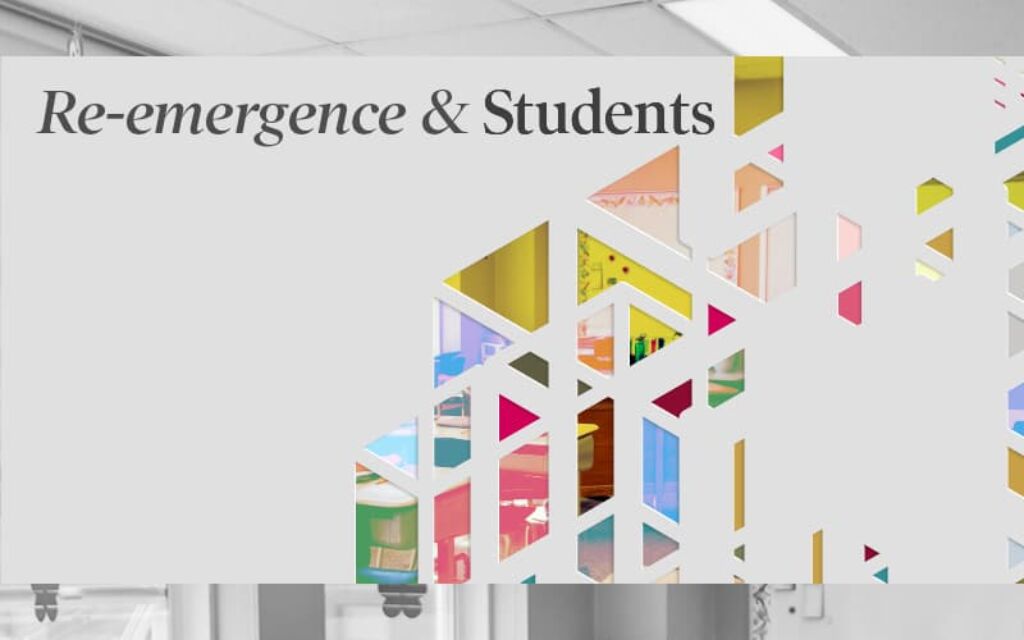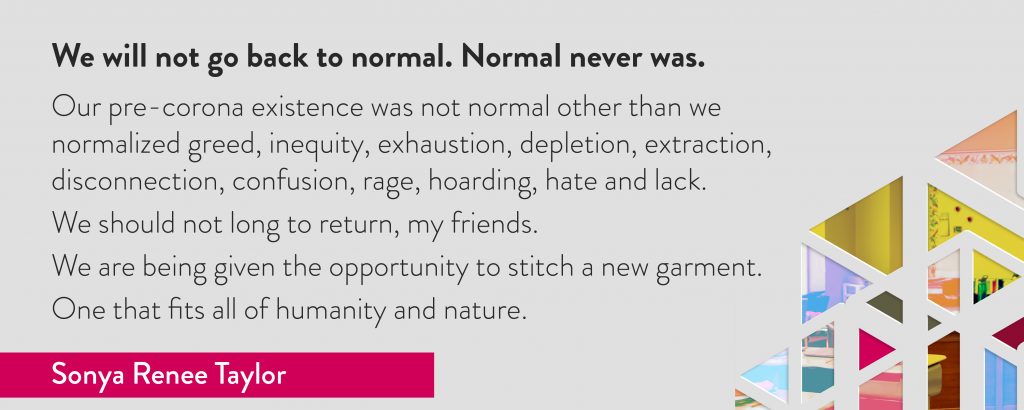Until a vaccine for COVID-19 is created, even a gradual re-emergence from the first and, potentially, second or third waves of self-isolation complicates everything.
How do we re-integrate students into schools when physical distancing will still be in order?
Will students who are immunocompromised or living with a family member who is immunocompromised be able to return to school? Or will they stay home to keep the family safe?
How will teachers navigate a return to the classroom while ensuring their own safety as well as their students?
What will schools need to make re-emergence work? Similar questions for child care centres. More janitors and cleaning measures will be needed, to be sure.
How do we turn the “on” button when proximity is still a problem?
Engaged learning and care in the context of physical distancing
The need for physical distancing as well as health and safety requirements for schools and child care facilities to reopen is complicated by the fact that the learning process necessitates collectivity and connection that is most possible when students and educators are in close physical proximity.
This article will focus on the considerations that must underpin a physically safe reopening of a sector that represents facilities that are simultaneously places of work, learning, and care.
It’s a sector that employs thousands of education workers, and educates and cares for hundreds of thousands of children, from infancy to near-adulthood in every community.
But this is also a sector in a position to both reflect and reinforce or, conversely, mitigate and help overcome the scourge of inequality. It’s a sector that, upon reopening, will face the full impact of the reality that this has not been an equal opportunity pandemic. COVID-19 has had tremendous ramifications for the emotional and mental health of children, their families, and its employees.
On May 11, elementary schools and child care centres in Quebec—the province at the epicentre of Canada’s COVID-19 outbreak—reopened. Attendance for children was optional, but it was mandatory for caregivers and staff.
"People need to get back to a normal life," said one principal.
The term “normal” is an interesting one, particularly because of what it implies in the context of our youngest children—those who need care—and their educators and caregivers positioned at the vanguard of reopening.
Back to “normal” is a proxy for getting people back to work—and getting off the CERB.
But “normal” in this context also means a return to a status quo that was unacceptable for so many: one that enshrined socioeconomic inequity, racism, misogyny, homophobia, ableism.
When “normal” is the state to which we are told we must return, we need to be aware of what untenable systems it also reinforces
Before any return can be considered, workers must be assured that proper protections are in place so that they are not being forced to choose between income and health.
This is already a concern, since the only reason workers can refuse to return to work and still receive the CERB is to care for children or other dependents. This stipulation, and the impossible choice between health and income, will disproportionately impact women and lower-paid workers, many of whom are racialized).
For schools and child care facilities to safely reopen for workers, students, and children, proper distancing requirements must be implemented, and safety equipment provided on demand.
But adequate workplace safety measures also include paid sick days and short- and long-term disability at the first sign of not just symptoms, but possible exposure, as negotiated in collective agreements.
These measures also keep students safe—an example of how collective agreements also provide protections for students and, indirectly, their communities and families, by limiting exposure and enforcing workplace health and safety standards.
Frequent cleaning and sanitizing school buildings and communally-used equipment for education or recreational purposes must be heightened. This requires greater numbers of qualified staff to ensure new and much higher standards of cleanliness and safety are met.
Before COVID-19, some of this work and these workers may have fallen victim to previous rounds of cost-cutting, which has implications not just for school maintenance and staffing numbers but for worker mobility between schools. There is no room for such austerity measures during a pandemic.
Worker mobility isn’t only an issue for custodial staff. Educators, particularly newer ones, can find themselves working at multiple schools and even at multiple boards in pursuit of a full-time, permanent position. This means one educator may come into contact with hundreds of students over the course of a few days, in several schools across a number of neighbourhoods.
The multiple-workplace issue, particularly in a sector that represents and cares for so many people, was identified as extremely problematic in the long-term care sector. It may have even greater implications for the education system, because at the end of each day these children and staff return home to their families, exponentially increasing circles of exposure and risk.
The risks are even greater for families where a member is immunocompromised: these children cannot return to school because of direct exposure. Immunocompromised parents cannot risk their child returning at the end of the day to expose their family to potential viral spread.
Without a vaccine, reintegration for families where a member is particularly vulnerable to becoming sick is simply not an option.
Recommendations for reopening schools and child care centres
For students, educators and staff in a position to return to school, the following measures must be in place—especially since it’s likely the recovery will not be linear:
- All workers must have safe workspaces to return to, or be provided with adequate support to stay home out of concern for their health.
- They must have adequate measures in place to ensure that if they do get sick, they have paid time off.
- Schools—as workplaces—must ensure the same safety measures are in place for their employees, taking into consideration the much greater proximity issues that educators experience compared to workers in many other workplaces.
- This requires more staff to maintain higher standards of cleanliness and fewer students per classroom (at a time when school closures are predicated on maintaining high levels of capacity).
- It will necessitate accommodating educational needs of students who may have to re-isolate for their own health reasons, or the health reasons of their family, which may have implications for the school year and work completion.
- Staff movement between schools must also be limited for educators, education workers, and administrators. This will become more difficult when an increasing number of exposed or infected employees will need to be temporarily replaced by occasional staff, whose status of being on-call across the board must also be re-examined in the context of COVID-19.
- Physical distancing measures must be prioritized—which has implications for space and scheduling during recess, phys ed, team sports, busing or transportation to and from school, and any collective activities.
- Class sizes were a growing concern even before the COVID-19 lockdown. All of this must be considered within the context of a funding formula that underfunds staffing needs and resources.
It doesn’t address schools as places of relationality, social transformation, well-being, and critically engaged learning. It also doesn’t address the populations and communities impacted by schools closures and by reopening.
It does not address necessary mental and emotional health supports for students, families, and staff who have just emerged from a deeply traumatizing experience—supports which were inadequate and under prioritized in the pre-COVID era.
It does not reflect the complex needs of students and their families, especially those who are racialized or marginalized, who may already have a traumatic relationship with the school system.
It does not detail the ways in which inequities and oppressions have been starkly revealed by COVID-19. The uneven response to these inequities must be addressed so that they are not maintained and worsened during, and after, the reopening phase.
As provinces begin to explore reopening and what it means in their particular context, the complexity of this endeavor comes into focus.
Few sectors provide the opportunity to truly appreciate the degree to which these processes are interconnected than education and child care, because of the multiple functions of these facilities: workplaces, learning environments, community hubs.
COVID-19 was not an equal opportunity pandemic—but the society and economy we maintain have never been equal opportunity, nor equal in outcome.
Education in a post-COVID-19 world must be rooted in the knowledge that too many were too poorly served to consider “going back to normal.” We need to go forward—building on what we have learned, and centring the needs of kids in considering what “safe” schools truly look like—as places of work, places of learning, and places of care.
This cannot be a recovery. For us to make progress in a post-COVID-19 world, this must be a re-emergence that necessitates re-examining every aspect of our education system.
Vidya Shah is Assistant Professor in the Faculty of Education at York University and her research explores anti-racist approaches to educational leadership and school district reform.
Erika Shaker is Director of the CCPA National Office and editor of Our Schools / Our Selves magazine. Find her on Twitter at @ErikaShaker.








